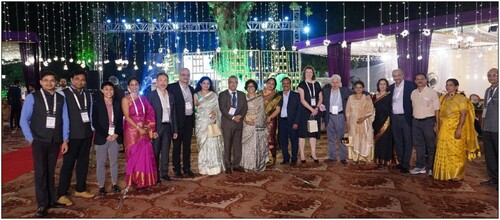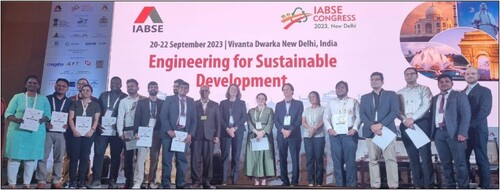Pre-Congress Meetings, Workshop and Congress, 18-22 September 2023
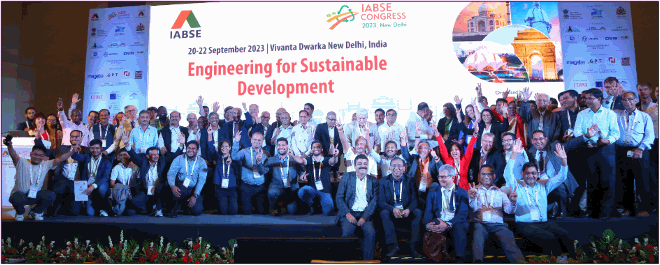
The IABSE New Delhi Congress 2023 concluded successfully, attracting over 500 participants from 37 countries. There were 212 Papers in 36 Parallel sessions during the Congress.
The Congress started on the 20 September 2023 with a captivating Bharatnatyam dance performance, setting the stage for an elaborate Opening Ceremony. The "Lighting of Lights" ritual symbolised values such as knowledge, wisdom, integrity, and truth, reminding attendees to uphold these principles throughout the conference. Mr PVVSS Ravi Prasad, the Chair of the Organising Committee (OC), warmly welcomed participants from around the world who had travelled to New Delhi to attend the Congress. IABSE President Dr Tina Vejrum thanked the Indian National Group of IABSE for hosting this IABSE Congress in New Delhi and welcomed and encouraged all participants to have this opportunity to have interesting and engaging discussions while gaining new friends. Dr Harshavardhan Subbarao, the Scientific Committee (SC) Chair, presented the detailed Technical Program scheduled for the following three days. The Opening Ceremony concluded with a "Vote of Thanks" delivered by Mr. B.K. Sinha.
This was followed by a special Felicitation session honouring IABSE Honorary Members Prof. S.S. Chakraborty and Dr. B.C. Roy (due to illness, his memento was handed over to Mrs. Dr Roy) and IABSE Vice-President, Dr H. Subbarao. Additionally, the ING-IABSE presented a "Certificate of Acknowledgement" to recognise the significant contribution of the OC Chair, Mr. PVVSS R. Prasad and IABSE President Dr. T. Vejrum.
L to R: PVVS Prasad, OC Chair; T.Vejrum, IABSE President and H.Subbarao, SC Chair; at the Opening Ceremony

Felicitation for S.S.Chakraborty, B.C.Roy and H. Subbarao and a token of Acknowledgement to PVVS R. Prasad and T. Vejrum
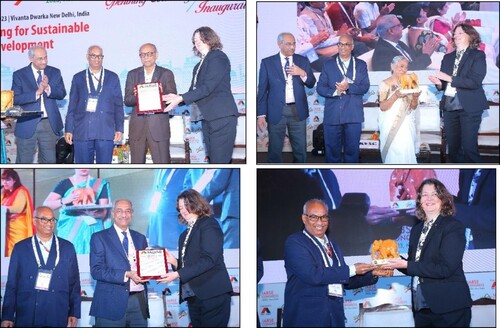
The Congress was preceded by four Pre-Congress Meetings and two Workshops. IABSE members from all over the world met for the Technical Committee, Administrative Committee, Executive Committee and Commission 1 hybrid meetings and continued their friendly and professional interactions over lunch and dinner at the Taj Vivanta Hotel. International experts from Chile, Denmark, India, Italy, Japan, Mexico, Switzerland, Spain, New Zealand, the US, and other countries surrounded the table like a big family gathering, continuing their professional and personal discussions and interactions. New participants were welcomed with the same warmth.
Pre-Congress Hybrid Meetings: Administrative, Executive, Commission 1, and Technical Committee meeting
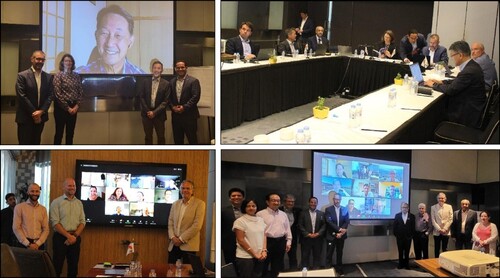
The Welcome Reception, held at the Taj Vivanta Hotel, featured a heart-pounding Kathak dance performance by Guru Abhimanyu Lal and his troupe of dancers. Following the performance, attendees were treated to a sumptuous buffet of authentic Indian cuisine. At the venue's main hall, participants enjoyed taking Group Selfie pictures at the Selfie Booth for a memorable photo at the Congress. They also appreciated the organiser's efforts in providing a medical doctor on-site on all five days of the Congress to ensure the safety and welfare of all participants during the Congress. To further enhance the cultural experience of participants, the OC extended their generosity by giving complimentary yoga sessions every morning, with instructors from Morarji Desai National Institute of Yoga, for a complete experience of "Incredible India".
Participants were happy to receive their high-quality rucksack - Delegate's Bag with the Final Program (FP), Souvenir Booklet, Congress Proceedings in print and Qutub Minar memento. The participants were provided with the best amenities, including bus transfers to and from the Congress events. The OC introduced a new registration system. Automated Kiosks printed name badges and individualised "Certificate of Attendance" by scanning the QR Code on the participant’s name badge, which worked well and was very efficient. 'Day passes' were also offered to local engineers to get a feel and discover IABSE conferences.
The Keynote Lectures and the Technical Sessions were well organised and highly appreciated by the participants due to the quality of discussions and the constant exchange of information and views during the presentations and the Q&A rounds. Chairs who chaired the Sessions were also pleased with the turnover of young engineers who participated and their papers that were presented. Keynote Lectures were given by S.S. Chakraborty on 'Engineering Solutions for Sustainable Development; Helena Gervasio on 'Code of Practice For Sustainable Structures', Petr Hájek on 'Changing Climate and Sustainability of Built Environment', Anurag Jain on 'New Initiatives to Sustainable Infrastructure Growth in India', David MacKenzie on 'Upgrade & Retrofit of Existing Infrastructure & How it Contributes to Sustainability to Extend the Service Life of Structures', Arun Menon on 'Sustainable Development Goals and the Debate of Demolition Versus Conservation in a Developing Economy', Leena Nandan on 'Sustainable Development Pathways to address Climate Change' and Sanjay Pant on 'The Role of Indian Standards & Special Publications Orienting Towards Sustainability Causes'. A well-organised Technical Tour on Wednesday and Thursday ran smoothly with trips to Delhi Metro Viaduct, Extradosed of Barapullah Phase III Bridge, and to the Signature Bridge. Participants travelled back and forth from the Congress venue to the location by air-conditioned buses. Accompanying Persons programs took place in parallel and were provided with many options to tour the city and neighbouring tourist spots.
At the Exhibitor's area, sponsors and exhibitors were provided a spacious area where Coffee Breaks were served between sessions. This provided an excellent opportunity for exhibitors, sponsors and delegates to converse about their latest products and services or simply network with other participants. To enhance the conversations and cultural experience of the delegates, the OC introduced additional fun activities like Henna (Indian tattoo), Caricature artists and 360-degree photo booths. The OC took extra care of every event related details to ensure that everyone attending the Congress had an experience of ‘Incredible India'.
Scientific Committee Report
Report by Harshavardhan Subbarao, Chair, Scientific Committee
Sustainable Development Goals (SDG) adopted by the United Nations in 2015 called for action by 2030 to end poverty, balance economic growth with social empowerment, and take climate-appropriate actions to save the planet. In the same year, the Paris Agreement on Climate Change required the nations to set their Nationally Determined Contribution to reduce Global warming.
As the world population grows and the impact of climate change becomes more severe, the demand for sustainable buildings and infrastructure has also increased. Moreover, durable and resilient structures are crucial aspects of sustainable construction. The resilient and durable structures which can withstand the vagaries of natural disasters reduce the need for frequent interventions of repairs and replacements, thereby reducing the resources required for maintenance.
To crystalise the way forward in the construction industry, The Indian National Group of The International Association for Bridge and Structural Engineering (ING-IABSE), fully supported by the Ministry of Roads and Surface Transport (MoRTH) hosted this International Congress on the theme "Engineering for Sustainable Development" in New Delhi at Taj Vivanta, Dwarka from 20-22 September 2023.
The primary goal of the IABSE Congress was to provide a platform for policymakers, engineers, scientists, industrial partners and practitioners to present and discuss the latest developments and state-of-the-art relevant to durability, sustainability and resilience. This Congress provided a platform for engineers to discuss and collaborate on achieving net zero carbon emissions by 2070. Various methods of design, use of new materials and technologies were part of the debate. The Congress covered various topics related to innovative materials, structural performance and design, construction methods & management, and some outstanding structures. In light of the collapse of various bridges in the recent time, two pre-congress workshops were organised on forensic structural engineering and design using strut and tie methods. In addition, three technical visits, showcasing modern infrastructure in India's rapid urbanisation were organised to – Signature Bridge Delhi, under-construction multi-span extradosed bridge on Yamuna and an under construction DMRC Package of viaducts and stations.
The main goal of the Congress was to create a forum for the debate on why sustainability with respect to environment, culture and social needs is important. The role of engineers is vital in addressing not only the bridge and structural engineering issues but also basic human needs such as alleviating poverty, supplying clean water and energy, responding to natural disasters, constructing resilient infrastructure, and bridging the development divide among people and many other actions, leaving no one behind. The Congress focussed on the most significant issues of our time, that of sustainability and the role of the engineer in accomplishing this goal. It is hoped that the Congress will serve as a platform for Governments, Engineering Organizations, academia and educational institutions, and industry to forge global partnerships and strengthen collaborations to deliver on the global sustainability development agenda.
Young Engineers Program
During the Congress, the Young Engineers Program for the participants included a Pecha-Kucha session, Young Engineers Prize, Pecha-Kucha Prize, Speed-Networking on all three days, Reserved Bar and Bowling, and a 'Bridge Model Competition', which was led by Jatin Singla, from the Indian National Group. Preparations were ongoing for several months with Igor Kavrakov (YEC Chair), OC, SC, and the IABSE Secretariat. The Young Engineers Program was a huge success during the Congress and set a platform for more young engineers from India to be part of IABSE.
During the 'Speed Networking' sessions, young engineers could interact with senior engineers face to face and get their valuable advice. Several young participants took this opportunity to meet, ask, and get advice from experienced engineers who had signed up for this program to mentor engineers in their early career paths. The special hall was sponsored by Prof. S.S.Chakraborty and his company. For all three days the mentors were: Mike Schlaich (Germany); Varsha Agarwal (India); Sudhangsu Sekhar Chakraborty (India, sponsor for the event); Alok Bhowmick (India); Stephen Hicks (New Zealand); Geralt Siebert (Germany); Harpreet Singh (India); Laurent Rus (Spain); Arndt Goldack (Germany); Aditya Sharma (India); Nirmalya Bandyopadhyay (India); Sumantra Sengupta (India); Tina Vejrum (President, Denmark); Jose Romo (Spain); Raad Abdul-Aziz (Switzerland); Helena Maria Gervasio (Portugal); Umesh Rajeshirke (India); Amitabha Ghoshal (India); Kartik Venkatachalam (India); and Mitja Papinutti (Slovenia).
On the first evening of the Congress, the 'Bridge Model competition' also took place for young engineers. Groups were divided, and they had to build bridges with spaghetti sticks and other materials, which was fun to watch! There was also an interesting Pecha Kucha Session, with fast-paced creative presentations by young engineers on any topic with 10 Slides. In the evening, they had a reserved bar where all those who are 'young at heart' could shake a leg to Bollywood tunes and play indoor cricket and bowling. The energy and enthusiasm was unmatched.
IABSE Pre-Congress Workshops
2-Day Workshop on Design of Structural Concrete with Strut-and-Tie Method on 18-19 September, 2023, New Delhi
Report by Arndt Goldack und Mike Schlaich; Workshop instructors
A two-day workshop on Strut-and-Tie Modeling for the Design of Structural Concrete was held prior to the 2023 IABSE Congress in New Delhi on 18-19 September 2023. The workshop was conceived and conducted by Prof. Arndt Goldack of the University of Wuppertal, Germany, Prof. Mike Schlaich of the Technische Universität Berlin, Germany, and Prof. Vasant Matsagar of the Indian Institute of Technology in New Delhi. The workshop was organised by the Indian National Group of IABSE (ING).
Strut-and-Tie Models (STM) are a wonderful tool to design reinforced concrete in a simple and understandable way. In fact, Strut-and-Tie Models have become part of many international design codes in recent years. Today, European, American and Canadian standards allow the design of structural concrete using Strut-and-Tie Models. While Strut-and-Tie Modeling is simple and easy to understand, experience has shown that a certain amount of training and practice is required to apply it successfully.
The two-day workshop on Strut-and-Tie Modeling was fully booked and was a great success. More than 50 participants attended the workshop. The participants were mainly from India but also from other countries like Bangladesh and Egypt. Among the participants were young professionals as well as experienced engineers from consulting and government.
All participants were not only introduced to the theoretical basics through lectures but also had plenty of time to develop their own Strut-and-Tie Modes in small groups. The local organisers had thought of everything, even coloured pencils, rulers, sharpeners and erasers were provided. There was no excuse not to practice Strut-and-Tie modelling on example worksheets. Numerous examples were worked on and discussed in a good working atmosphere. There were interesting discussions on how to find a good model. In addition, many participants took the opportunity to discuss design problems from their own practice, such as diaphragms in hollow box girders and pile caps.
(Late) Prof. Jörg Schlaich and Prof. Kurt Schäfer were strongly involved in developing this method since the beginning of the 1990s and have disseminated it through numerous workshops and courses. This included a workshop at the 1993 IABSE Congress in New Delhi. The organisers believe that even after thirty years, such a workshop is still an important contribution to the training of engineers and for quality assurance in the design and construction of structural concrete. The conductors of the workshop definitely enjoyed it!
IABSE New Delhi 1-Day Pre-Congress Workshop on “Reliable Forensic Investigation – Causes, Investigation Methods and Lessons Learned to Mitigate Failures” on 19 September 2023
Report by Laurent Rus and Karel Terwel; Workshop Instructors
The Congress under the theme “Engineering for Sustainable Development” had some important milestones for IABSE Task Group (TG 5.1) on Forensic Structural Engineering. In addition to traditionally chairing some of the multiple parallel technical sessions, TG 5.1 delivered a Pre-Congress Workshop on Forensic Structural Engineering (FSE), in collaboration with the New Delhi Scientific Committee (SC).
This workshop was organized jointly with the Indian National Group (ING) of IABSE, including TG5.1 members Harshavardhan Subbarao–Chair, Scientific Committee (SC), Karel Terwel–Chair, and Laurent Rus– Vice Chair) and local expert engineers Alok Bhowmick and V.N. Heggade, both members of the SC. The workshop's focus was “Reliable Forensic Investigation – Causes, Investigation Methods and Lessons Learned to Mitigate Failures”.
The workshop was structured on a full day session, the morning session covered an introduction to Forensic Structural Engineering and the presentation of different technical investigation methods, ranging from:
– TU Delft method: based on the definition of the problem, the development and validation of the failure hypothesis based on the observed data/data collected;
– Top-Down method: based on identifying the critical stage over the life cycle of a structure, guided by good industry practice, standard of care referenced to applicable Norms/Codes;
– Bottom-Up method: based on tracing back the physical mechanism leading to the observed pathology/failure.
The afternoon session was dedicated to case studies and a training session that included an overview of the FSE Practice in India and four case studies: Bridge Pier Cap failure, Bridge failure during erection of precast concrete segmental box girder, failure of steel twin arch bridge, and vertical cracks in the steining of a caisson foundation. The training session (group work) was based on the B-Tower partial collapse during construction work. For each of the above case studies, methodology to be adopted for investigations and lessons learnt were presented in addition to the Indian initiative CROSFALL for confidential reporting of structural failures.
The workshop was attended by 40 engineers from Government, Consultants and Contractors, ranging from young to mid-career and experienced engineers, with very active and interactive “question/answer” sessions, which demonstrated a high interest in the practice of Forensic Structural Engineering for a better understanding of the origin and causes of structural failures.
This workshop is made available to the SC of each new IABSE Congress or Symposium by IABSE TG5.1, and completed its 6th edition in New Delhi after conducting the same in New York, Nantes, Vancouver, Stockholm and Geneva; which was originally envisioned and developed by (Late) Robert Ratay, first chair of the IABSE TG5.1 (formerly Working Group 8).





